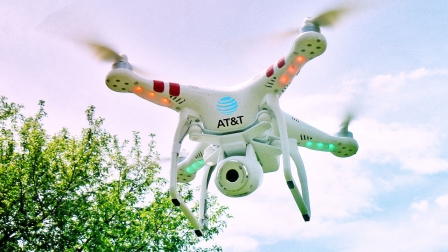Coming Soon To AT&T’s LTE Network: Drones
The days of drone-delivered pizza are getting a little closer.
Qualcomm announced today that it is partnering with AT&T to test drones out on the carrier’s LTE network. The network would ideally provide a stable connection between a drone and its on-the-ground pilot during flight, enabling the unmanned vehicle to do something such as drop a hot pepperoni on your doorstep, without worrying about any potential connectivity issues between it and your favorite neighborhood pizzeria.
“LTE connectivity has the potential to deliver optimal flight plans, transmit flight clearances, track drone location, and adjust flight routes in near real-time,” said Chris Penrose, senior vice president of IoT Solutions at AT&T, in a statement. “Solving for the connectivity challenges of complex flight operations is an essential first step to enabling how drones will work in the future.”
Using AT&T’s network could potentially give drones a longer range, as well as help them navigate more easily through city streets. Cellular networks could also potentially be used to create an air-traffic control system of sorts that would help drones communicate and avoid each other (and nasty collisions) while in the air.
Testing will happen at Qualcomm’s San Diego campus, where the chipmaker has built an FAA-authorized flight center. The center has a number of simulated “real world” scenarios for the drones to fly over, such as residential and commercial areas, as well as FAA-controlled airspace. Testing in a closed environment allows the two companies to try things out without impacting AT&T customers nearby.
With the trials, Qualcomm and AT&T will attempt to determine how drones can operate both safely and securely on AT&T’s current 4G LTE network (the same network your smartphone uses to surf Facebook right now), as well as future networks like 5G. They’ll monitor signal, strength, coverage, and mobility moving between different network cells, and how those charges effect a drone during flight. The idea would be to work out some of the kinks before taking the drones out for a spin in a real city.
The tests are based on the Snapdragon Flight development platform, which Qualcomm created in an attempt to expand beyond its success as a maker of smartphone chips into drones. Unveiled last September, Snapdragon Flight helps determine a drone’s exact location and helps a drone visually navigate a location. The technology is already used in some commercial drones, and drone-giant Yuneec is one of the company’s customers.
As for when the technology might actually be used to deliver that pizza, only time will tell.
Fast Company , Read Full Story
(33)


